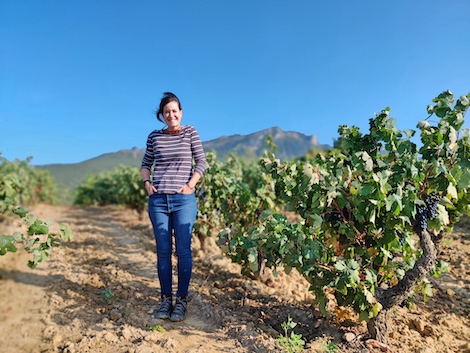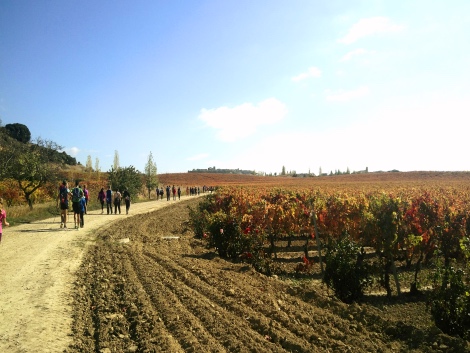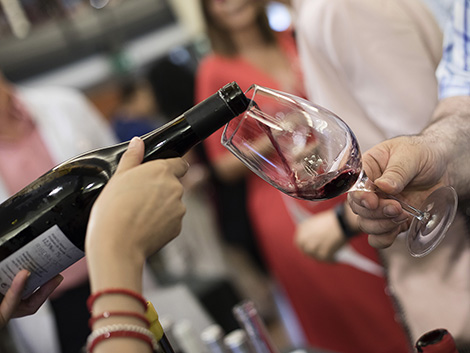Sandra Bravo: In search of the flavour of Sierra de Toloño in Rioja

Sandra Bravo has learned many things since her first vintage in Rioja in 2012, but there is one she values especially. "The people of Villabuena have taught me to live without haste. When I rented the winery I wanted to have everything preplanned. Now I'm more relaxed. This village takes the stress out of you,” says this Logroño-born winemaker and the first in her family to work in the wine business.
She returned to Rioja after seven years as vineyard manager in Priorat and after works stints in places such as Chianti or California. With this experience and the philosophy of life learned from the people of Villabuena, Sandra has laid the ground for her project Sierra de Toloño, first with rented vineyards in Rivas de Tereso where she continues to produce her white and red Sierra de Toloño cuvées —her tremendously fresh and fine village wines— and then with a further 9.5 hectares of her own vineyards in this village at an elevation of 650 metres, in the shadow of the ruins of the Santa María de Toloño monastery, and around Villabuena.
"I want to go step by step but there are buying opportunities that you just can't let them go by,” explains Sandra, who owns around two dozen plots, most of them old. "I prefer to own my vineyards because that allows me to manage them as I want and not be dependent on anyone, although normally I'm the last in the pecking order, but sometimes they like me and I get a call.”
Mountain Garnacha
It was more or less what happened with the garnachas planted in 1944. With them she makes La Dula, one of her single-vineyard wines, since 2016. "I had seen the vineyard before because I walked by it every day and finally the former owner, a man from Rivas, sold it to me in 2015," says Sandra, who stopped tilling the vineyard and recovered the rows that were pulled out between the 80s and 90s to let the tractor in. She grafted them with material from the vineyard to avoid the nursery plants and has gradually seen it blossom again: "It's amazing to see how many flowers and plants grow when you stop spraying herbicide. I even have wild garlic!”
She works the vineyard as in the old days and that is her humble tribute to the growers who planted Garnacha in the mountains, a variety that used to be widely planted in the Sonsierra area, now dominated by Tempranillo. "It is a pity that it was lost. Garnacha needs freshness and height and here there is a lot of underground water so the plants never suffer from drought. Sometimes you do find couture resulting in reduced yields, but that also means that the grains are looser and the grapes have the real flavour of local Garnacha", adds Sandra.
Maybe because of the years she spent in Priorat or simply because she likes a challenge, Garnacha is Sandra's favourite variety and she makes two wines with it. La Dula is fermented and aged in amphorae, something so unusual in Rioja that when she brought them to the winery, she had the neighbours of Villabuena on the banister watching her work with them. This is not fashion, she says. In the amphorae, she has more control over the ageing than in barrels and believes that it is the most suitable vessel to preserve the delicate, floral notes of Garnacha. "I have tried stainless steel, but Garnacha breathes and performs better in the amphorae. In the end each of us needs to find a custom-made suit for our vineyards", she says.
Landscape and biodiversity
The first vintage (2018) of La Dula Viñas de Altura has just been released, a delicious Garnacha, sheer freshness and enjoyment, made from grapes purchased from four old-vine plots in Rivas that she hopes to retain for a long time, because it is difficult to find old Garnacha in this area. Like La Dula, further down the slope, the vines are planted in white clay soils of calcareous origin from mountain sediments. In the case of Viñas de Altura, the destemmed grapes are fermented in 1,200-litre oak vats and then rounded off in the amphorae.
This is the type of mountain Garnacha Sandra likes to make and drink. " It may be a little risky, but I want it to be a mineral wine, subtle and ethereal, reflecting the area it comes from", she explains. "I don't bleed the grapes to have concentration; I make the wine straight from the vineyard although in cool areas like Rivas you have to be careful with the tannins, avoiding fragments of stalks and working very gently. The key is to wait and harvest Garnacha at the right time; if you pick it a little late it can be too alcoholic.
Descending a few meters down La Dula slope you arrive at Camino de Santa Cruz, a rented vineyard where she makes a single-vineyard Tempranillo and picks the Viura grapes for her Sierra de Toloño village white. Both here and in La Dula, the wind blows relentlessly helping to keep the grapes aerated and botrytis at bay. The vineyards are surrounded by green forests, bouquets of rosemary and lavender and cereal fields, with the monastery to the north and vast sweeping views all the way to the Castle of San Vicente to the south. "This biodiversity around us is also important for the vineyard. I find it difficult to explain with words the energy and magic of this place but I try to get my wines to express it", confides Sandra, who does not till her old vines and only uses horsetail as a fungicide and sulphur for powdery mildew.
Camino de Santa Cruz, which used to be called Rivas de Tereso, is her first single-vineyard wine. The winemaking process is simple: it is fermented in tinajas for almost a month and aged in neutral 500-litre barrels for about 10 months to round out the tannins. According to Sandra, it mirrors the area' potential.
"The vineyard has a large stone slab close to the surface providing extra minerality. Sierra de Toloño, the village wine from this same area, is sheer freshness while Camino de Santa Cruz is more intense, with aromatic herbs, Mediterranean forest and extra complexity.” Sandra thinks it is very important to know the taste of each vineyard when the ripening season arrives. "There are vines that you try and they don't taste of anything, perhaps because they are well irrigated. They may have all the sugar, tannin and colour parameters in place but they lack the flavour.”
Pruning in April
She thinks the 2019 vintage will be excellent, at least in her vineyards. "There have been no problems during the year and the rain came when it had to," says Sandra, who usually harvests in Rivas in October. Yields are lower, but since that is not her battle, she is very happy with the quality. "I would happily sign to have every year like this."
These good omens are supported by her decision to prune in April, a task that is set on the calendars of many growers in Rioja to be performed after the New Year. "Late spring frosts are more frequent and have become a problem across Europe; I also saw it on the Loire a few months ago", she adds. "My neighbours in Rivas said that I was crazy pruning so late, but then they see that I had no frost this year and I tell them that their vines could also be frost-free. But they won't do it because old habits die hard such as pruning according to the calendar or ploughing the grass right before harvest; they believe that if they change them their vines would look shoddy". And is the vegetative cycle not delayed when pruning so late? Perhaps a bit, but that’s not a problem either.
People here say that a day in October is worth a week in September, and it's true because temperature contrast increases and nights are cooler," explains Sandra.
In Villabuena, at almost 500 metres above sea level, she usually harvests a couple of weeks earlier than in Rivas, which allows her to stagger the work both in the vineyards and in the winery. As in the mountain, she leases and owns vineyards, where she makes one village and two single-vineyard wines, although neither these nor the five wines from Rivas are in the new DO Rioja classification.
"Since I started, I explain that I make artisan village and single-vineyard wines. Maybe the big wineries find this classification useful, but in my vineyards you can see where everything comes from", explains Sandra. "Furthermore, the requirement that the winery must be where the vineyards are since absurd to me. As my winery is in Villabuena, I couldn't make village wine from Rivas de Tereso. What’s the point of joining the new classification with some wines and not with others? It would only mean more paperwork".
Do you feel represented by the Council? “I feel that they are very detached from what I do. I just go there and do the paperwork, but it's a very strict bureaucracy which doesn't help the people,” concludes Sandra, who prefers to do her own thing and spend her time in the winery or recovering her vineyards.
The wines of Villabuena
One of them is in Samaniego and is planted among olive trees with 80-year-old Tempranillo, Viura and red and white Garnacha. "When I purchased it in 2016 it was full of rosemary and the vines were hardly visible. It is very pleasant to see flowers and life now but recovering a vineyard takes a long time. I kind of have the original plant here and that will allow me to reproduce the flavour of this site although the plants will need three more years to start producing great grapes,” reckons Sandra, who expects very small yields because she pruned too short last year. “I follow the advise of veteran grape growers like Enrique [owner of the vineyards and the winery she rents] and Ramón [owner of the vineyards in Rivas] who have lots of experience. In the end, it's about getting to know your vineyards and seeing what's good for them, but it takes years to understand them. It's like wines —over time you get their right point and their balance.
The other vineyard she purchased is in Villabuena and is about 100 years old. "They didn't spray herbicides on it, so with the rain we get here and a good trim once a year, it is well controlled. This really is an aesthetic issue because the vineyard doesn't need it," says Sandra, looking at a neighboring vineyard with puddles between the plants. "It's better to leave a little grass than to have mud, which creates problems to work in the vineyard, can delay the harvest and is also a seeding ground for fungus.”
The Villabuena vineyard, with imposing views of the mountains, sits on a gentle slope on stone slabs visible on the surface. "I call this plot El Coster because it reminds me of Priorat", says Sandra, whose partner is José Mas, winemaker at Costers del Priorat. "If I lived closer I would make wine there, although not with José, because we are incompatible to work together," she laughs. "Priorat has been a big influence for me.”
From El Coster plus the vineyard in Samaniego and three other tiny plots with very old vines in Villabuena, Sandra makes her wines Nahi Blanco and Nahi Tinto. Starting on the 2018 vintage these wines will be called Nahikun (desire, in Basque). “I really liked these plots but everyone said I was mad buying them, hence the name. It is something very personal, for which I have fought a lot. Plus I wanted to give my Villabuena wines to have a Basque name.”
Nahi Blanco is a blend of Rojal, Calagraño, Viura, Malvasía and Garnacha Blanca. It is fermented in 500-litre barrels with the lees to gain volume. It rests there for about eight months but she tries to avoid vanilla and oak notes to maintain its freshness. "For me, Villabuena wines are calmer, they have the character of the people of Villabuena. On the other hand, the vineyards in Rivas are like wild horses and the wines are also more extreme,” says Sandra, who plans to make around 1,000 bottles from the 2018 vintage.
The red wine is mostly Tempranillo but with some Graciano, Mazuelo and Garnacha. It is fermented in open barrels and aged for almost a year in 225-litre oak barrels, because she makes only about 600 bottles. "With such low yields, it's pure polyphenol, colour, tannin and acidity, but I have to work the vineyard to control this concentration and structure," explains Sandra, who destems all the grapes that enter her winery and only buys new barrels and casks that she rinses with wine before ageing her cuvées. Cement tanks are used to blend and rest the reds before bottling. They are neither filtered nor clarified.
Raposo is the name of her village wine and comes from two plots on calcareous soils. The youngest is 60 years old and both are planted with Tempranillo and around 5% Graciano. "The Villabuena people used to be called raposos and this wine for me represents the calm character of the locals. It also has the taste of Tempranillo from Rioja Alavesa, fresh and with good red fruit. I hope to fine-tune its structure over time."
A hermit with passion
A perfectionist by nature, Sandra is happy with her evolution —since our visit in 2015 she has released six more wines— but she believes she can do much better, especially her work in the vineyard, and she doesn't reject criticism because it keeps her on her toes. "When I got pregnant there were a lot of people, even people my age, who told me that I wasn't going to be able to handle both. I raised my game, made my best vintage so far (2018) and sold more than ever," she says proudly.
At the same time, critic Tim Atkin named her Rioja's best young winemaker. Sandra, who likes to go unnoticed and defines herself as a "hermit", did not expect such praise.
"Suddenly, friends began to pop up everywhere, even some very well-known producers, who wanted to know what I do, as if there was a magic formula; the truth is that, apart from putting all my heart and passion into making my wine, I have simplified things in the winery," explains Sandra, a member of the Rioja 'n' Roll group of producers. "I think I have a good instinct for vineyards, but over time I've realised that the human factor is 80% because the same vineyard managed by someone else can be totally different. It's a matter of understanding it and having sensitivity, of accepting that you may lose wine when you're racking. To a great extent, the expression of the vines is the expression of the person who takes care of them”.
She wholeheartedly rejects her wines being described as feminine. “I’d rather be invisible and have the wines speak and express the work and passion I put into making them, but I profoundly dislike being categorised by gender. I want to play in the same division as other people and I want people to speak about my wines". She complains, and rightly so, about the patronising attitude that many women still suffer in this sector. "I was thinking about buying a vineyard earlier this year and the owner said to me, 'Check with your husband and come back to me'. And I said to him, what do you mean I'm the one who pays and works! I'll be 60 years old and they'll still be saying things like that to me.”s
Just as owning vineyards is important to her, she is very comfortable renting her bodega from Enrique, the grower who helps her out in the Villabuena vineyards. She is building up a small office in the winery and is slowly painting the building inside when she finds the time, but her goal is to spend more time in the vineyards, trying to understand what they need and continue refining and searching for the flavour of their wines. "I have one thing in mind this vintage", confides Sandra. "I don't want to tell you much more in case it's jinxed, but I'd like to make a wine in the style of Garnacha de Altura."

Yolanda Ortiz de Arri
A journalist with over 25 years' experience in national and international media. WSET3, wine educator and translator
NEWSLETTER
Join our community of Spanish wine lovers






